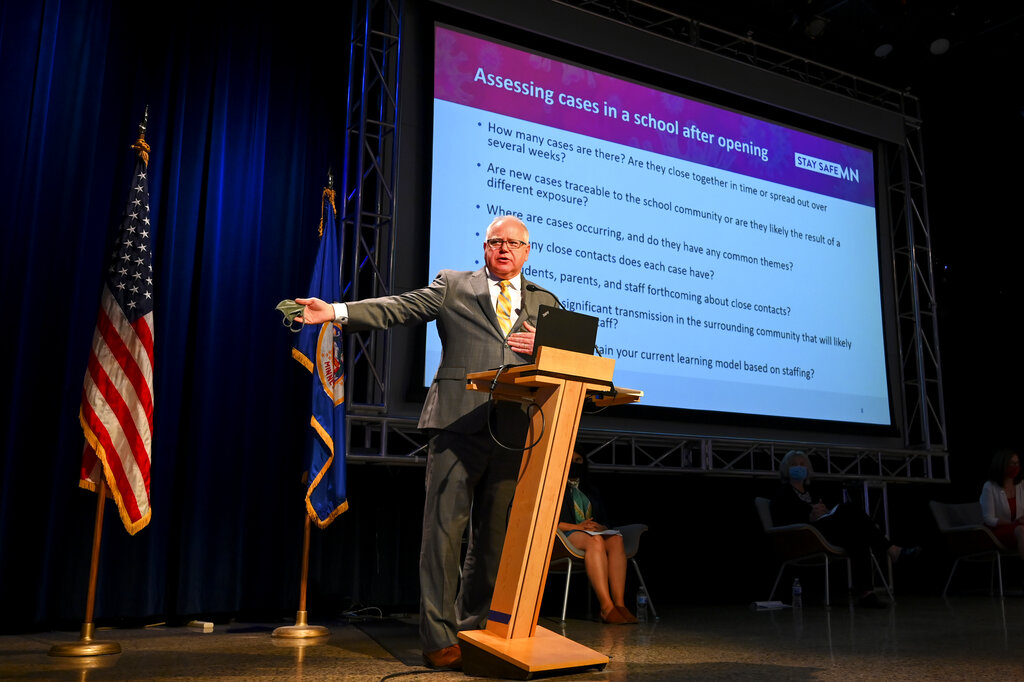
Minnesota Gov. Tim Walz takes part in a news conference to announce the learning plan for Minnesota schools for the upcoming 2020-21 school year at TPT’s St. Paul, Minn., studio Thursday, July 30, 2020. (Aaron Lavinsky/Star Tribune via AP, Pool)
Minnesota state officials on Thursday unveiled a plan to reopen schools this fall that gives districts some flexibility to toggle between in-person and online learning, but reserves the right for the state to step in if the coronavirus gets out of control.
Gov. Tim Walz acknowledged the importance of schools and the value of in-person learning, but said the state’s top priority is safety. Districts will work with the state Health and Education departments to determine whether to use in-person instruction, online learning or a hybrid model, and will have the ability to become more or less restrictive depending on the virus.
“When people say ‘open schools,’ that’s not a plan, that’s a slogan,” said Walz, a former public school teacher. “We all believe we need to get our students back there, but you are owed the best plan with the best resources … and the best practices that are being deployed not only here but in other states and other countries around the world.”
State education officials will use data on virus cases in a county to help districts determine which model they should use. Those with fewer than 10 cases per 10,000 people — measured over a 14-day average — could teach in person. Those with 50 or more cases would have to use distance learning. Levels in between would be suited to hybrid models.
Health Commissioner Jan Malcolm said the figures will be used as a starting point in the districts’ decision-making process, which should include plans to manage risk of infection, like masking policies, frequent cleaning, social distancing and limiting large gatherings.
“After the decision to open is made, that’s not the end of the conversation,” Malcolm said. “There will be ongoing evaluation and ongoing consultation about what’s happening with virus transmission and the schools’ ability to continue to build up these mitigation and best practices, and what’s going on in the community around some of the mitigation strategies that we know are so very important.”
The plan requires both public schools and charter schools to allow students and teachers to choose remote learning no matter what model the district chooses. The state will also provide a cloth mask to every student, teacher and adult working at schools, a clear face shield to every teacher and three disposable masks per student to every school in the state.
Heather Mueller, deputy education commissioner, said support teams composed of state officials and local public health officials will help schools implement the plan and respond when a student or school employee tests positive for COVID-19. To ensure access to testing for schools at no cost, Mueller said every teacher will receive one saliva test for their classroom, school staff will get priority for testing as critical workers and universal testing may be considered for outbreak areas.
Republicans and some school officials had pressed Walz to leave reopening plans up to individual districts, arguing that local administrators know best how to protect students.
GOP Senate Majority Leader Paul Gazelka said the plan should have come sooner, and that there will be still more delay while districts finalize plans. He also said he was “concerned” that the state can still order schools back to distance learning.
The guidance comes as coronavirus cases have been moving upward in some parts of the state. Minnesota reported 745 new cases on Thursday — slightly higher than the seven-day average — and five new deaths. State officials have warned of rising hospitalizations, but that number dipped slightly in Thursday’s data.
President Donald Trump has pressed schools nationwide to open for in-person learning, and as many teachers have expressed fears of doing so. Education Minnesota last week released a survey with just one in five teachers supporting in-person learning.
The union said in a statement it welcomed the use of data and flexibility in the plan but cautioned that more steps are needed before safely reopening.
“Physically opening school buildings to our students will take a tremendous amount of work from everyone in the school community – school board members, administrators, educators and parents – before we can do it safely,” President Denise Specht said. “We cannot be bullied by arbitrary start dates on the calendar or settle for ‘safe enough’ because that’s all an underfunded district can afford. In-person and hybrid learning shouldn’t start until our schools are ready.”
